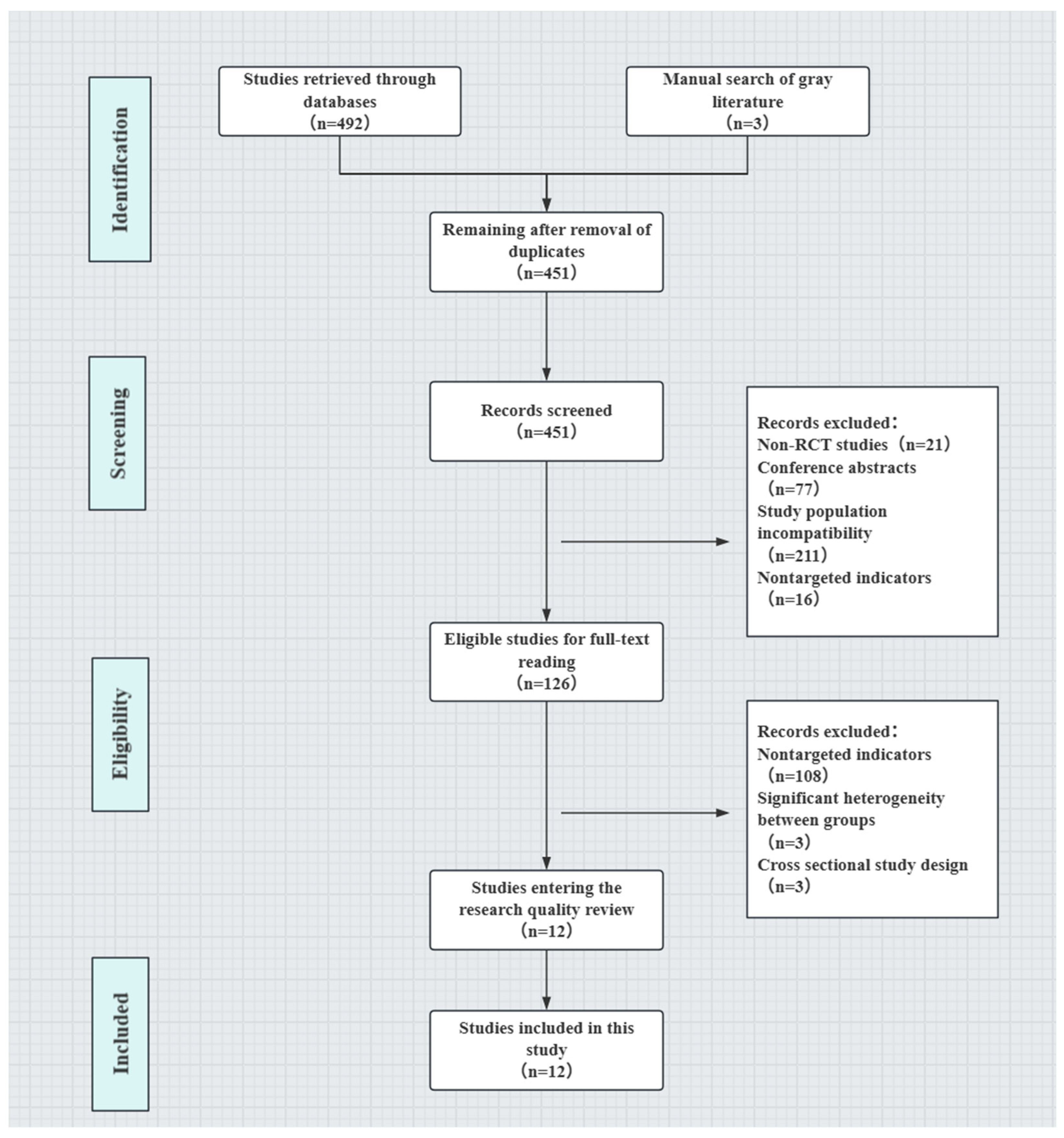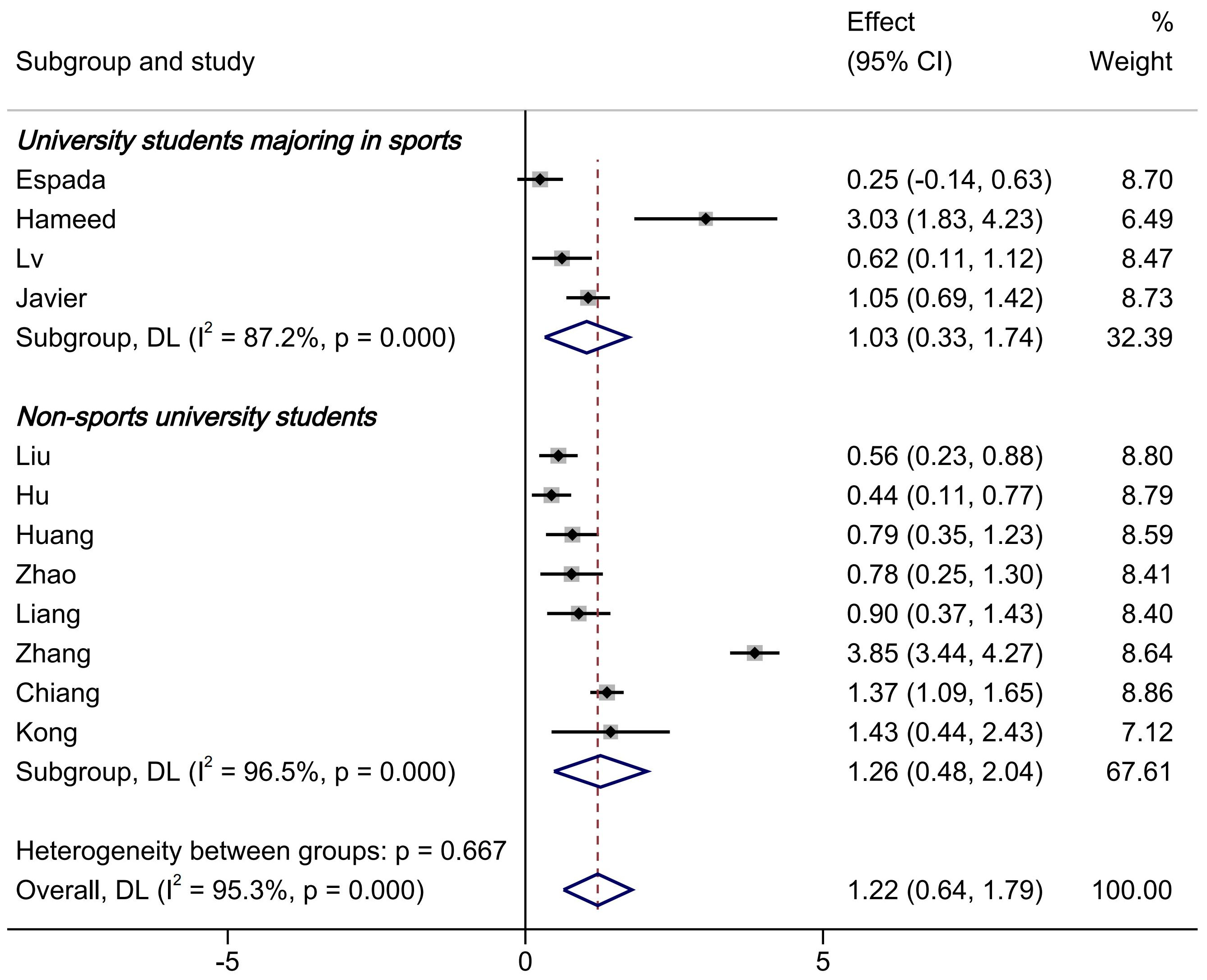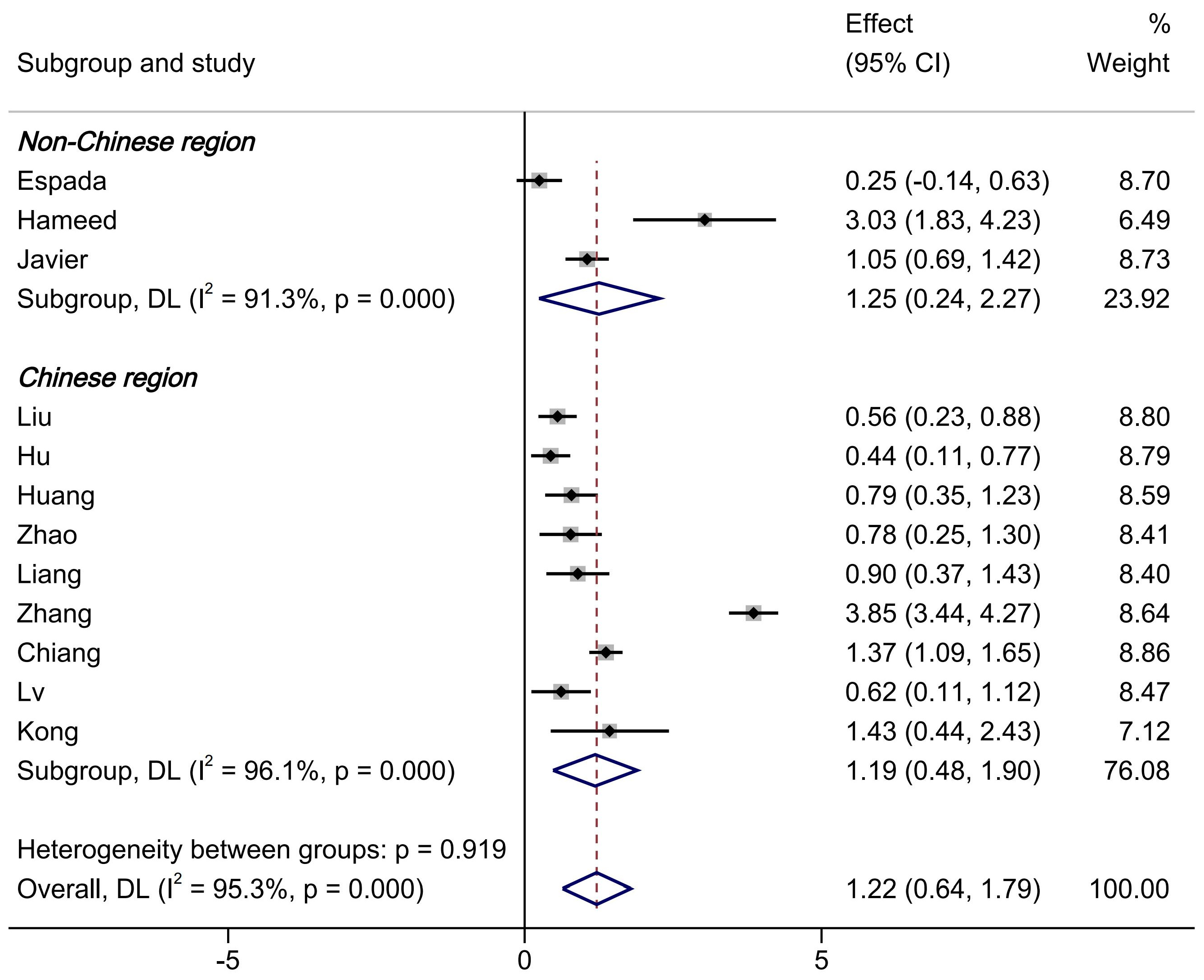Impact of Flipped Classroom Instruction on Brain-Mediated Motor Skill Performance in University Students: A Systematic Review and Meta-Analysis
Abstract
1. Introduction
2. Materials and Methods
2.1. Inclusion and Exclusion Criteria for the Study
2.2. Literature Search Strategy
2.3. Literature Screening
2.4. Quality Assessment of Included Studies
2.5. Statistical Analysis
3. Results
3.1. Results of Literature Search
3.2. The Result of Quality Assessment of Included Studies
3.3. Results of Meta-Analysis
3.4. Subgroup Analysis
3.4.1. Subgroup Analysis by Student Population
3.4.2. Subgroup Analysis by Region of Study
3.5. Egger’s Test
4. Discussion
4.1. Strengths of This Study
4.2. Limitations of This Study
4.3. Suggestions for Future Research
5. Conclusions
Supplementary Materials
Author Contributions
Funding
Acknowledgments
Conflicts of Interest
References
- Gallahue, D.L.; Ozmun, J.C. Understanding Motor Development: Infants, Children, Adolescents, Adults, 5th ed.; McGraw-Hill: Dubuque, Iowa, 2002; ISBN 978-0-07-235366-2. [Google Scholar]
- Seefeldt, V.; Haubenstricker, J. Patterns, Phases, or Stages: An Analytical Model for the Study of Developmental Movement; Wiley: New York, NY, USA, 1982. [Google Scholar]
- More, P. The Vital Role of Physical Education and Sports in Holistic Development. J. Nov. Physiother. 2023, 13, 648. [Google Scholar]
- Justiz, D.M. Donation of a Mexican House of Higher Education to the University of Las Tunas. Available online: https://www.periodico26.cu/index.php/en/education-2/16103-donation-of-a-mexican-house-of-higher-education-to-the-university-of-las-tunas (accessed on 8 May 2025).
- Wibowo, J.; Krieger, C.; Gaum, C.; Dyson, B. Bildung: A German Student-Centered Approach to Health and Physical Education. Eur. Phys. Educ. Rev. 2023, 29, 233–250. [Google Scholar] [CrossRef]
- Journal of Physical Education, Recreation & Danc|Taylor & Francis Online. Available online: https://www.tandfonline.com/journals/ujrd20 (accessed on 25 November 2024).
- Owen, N.; Healy, G.N.; Matthews, C.E.; Dunstan, D.W. Too Much Sitting: The Population-Health Science of Sedentary Behavior. Exerc. Sport Sci. Rev. 2010, 38, 105–113. [Google Scholar] [CrossRef]
- Bessa, C.; Hastie, P.; Ramos, A.; Mesquita, I. What Actually Differs between Traditional Teaching and Sport Education in Students’ Learning Outcomes? A Critical Systematic Review. J. Sports Sci. Med. 2021, 20, 110–125. [Google Scholar] [CrossRef] [PubMed]
- Zhang, T.; Yang, M.; Chang, H. New Direction of National Traditional Physical Education Teaching Reform under the Background of Network. Agro. Food Ind. Hi-Tech. 2017, 28, 2–5. [Google Scholar]
- Bai, Y. Research on the Design Method of Physical Education Curriculum Based on the Flipped Classroom Concept. Educ. Sci.-Theory Pract. 2018, 18, 1604–1611. [Google Scholar] [CrossRef]
- Jalla, A.; Sturges, J.; Lees, J. Integration of Educational Technology. Surg Clin. N. Am. 2021, 101, 693–701. [Google Scholar] [CrossRef]
- Dong, C.; Szarek, J.L.; Reed, T. The Flipped Classroom and Simulation: A Primer for Simulation Educators. Med. Sci. Educ. 2020, 30, 1627–1632. [Google Scholar] [CrossRef]
- Oudbier, J.; Spaai, G.; Timmermans, K.; Boerboom, T. Enhancing the Effectiveness of Flipped Classroom in Health Science Education: A State-of-the-Art Review. BMC Med. Educ. 2022, 22, 34. [Google Scholar] [CrossRef]
- Huang, J.; Yu, D. Application of Deep Learning in College Physical Education Design under Flipped Classroom. Comput. Intell. Neurosci. 2022, 2022, 7368771. [Google Scholar] [CrossRef]
- Yom, K.H.; Diel, R.J.; Kemp, P.S. A Comparison of the Flipped Classroom Model for Medical Student Education in Ophthalmology before and during the COVID-19 Pandemic. J. Acad. Ophthalmol. (2017) 2021, 13, e228–e233. [Google Scholar] [CrossRef] [PubMed]
- Kong, Y.; Wang, W.; Rajabov, B. New Model of College Physical Education Teaching Based on the Algorithm and Data Structure of Flipped Classroom and OBE. Heliyon 2024, 10, e31368. [Google Scholar] [CrossRef]
- Wei, W.; Wei, J.; Fang, W. Application Analysis of Flipped Classroom Based on Wechat Public Platform in Basketball Physical Education Teaching. J. Phys. Conf. Ser. 2021, 1744, 042228. [Google Scholar] [CrossRef]
- Hu, T.; Zhang, M.-L.; Liu, H.; Liu, J.-C.; Pan, S.-J.; Guo, J.-H.; Tian, Z.-E.; Cui, L. The Influence of “Small Private Online Course + Flipped Classroom” Teaching on Physical Education Students’ Learning Motivation from the Perspective of Self-Determination Theory. Front. Psychol. 2022, 13, 938426. [Google Scholar] [CrossRef] [PubMed]
- Chen, Z. Deep Learning Algorithm for Online College Physical Education Teaching with Flipping Classroom. Comput. Intell. Neurosci. 2022, 2022, 8742661. [Google Scholar] [CrossRef]
- Kim, N.; Ae, C.B.; Choi, J.-I. A case study of Flipped Learning at College: Focused on Effects of Motivation and Self-efficacy. Educ. Eng. Res. 2014, 30, 467–492. [Google Scholar] [CrossRef]
- Moher, D.; Liberati, A.; Tetzlaff, J.; Altman, D.G.; PRISMA Group. Preferred Reporting Items for Systematic Reviews and Meta-Analyses: The PRISMA Statement. PLoS Med. 2009, 6, e1000097. [Google Scholar] [CrossRef]
- Sánchez Martín, M.; Olmedo Moreno, E.M.; Gutiérrez Sánchez, M.; Navarro-Mateu, F.; Sánchez Martín, M.; Olmedo Moreno, E.M.; Gutiérrez Sánchez, M.; Navarro-Mateu, F. EQUATOR-Network: A Roadmap to Improve the Quality and Transparency of Research Reporting. Espiral. Cuad. Del Profr. 2024, 17, 108–116. [Google Scholar] [CrossRef]
- Cooke, A.; Smith, D.; Booth, A. Beyond PICO: The SPIDER Tool for Qualitative Evidence Synthesis. Qual. Health Res. 2012, 22, 1435–1443. [Google Scholar] [CrossRef]
- Zotero|Your Personal Research Assistant. Available online: https://www.zotero.org/ (accessed on 25 March 2025).
- Vu-Ngoc, H.; Elawady, S.S.; Mehyar, G.M.; Abdelhamid, A.H.; Mattar, O.M.; Halhouli, O.; Vuong, N.L.; Ali, C.D.M.; Hassan, U.H.; Kien, N.D.; et al. Quality of Flow Diagram in Systematic Review and/or Meta-Analysis. PLoS ONE 2018, 13, e0195955. [Google Scholar] [CrossRef]
- Risk of Bias 2 (RoB 2) Tool|Cochrane Methods. Available online: https://methods.cochrane.org/risk-bias-2 (accessed on 8 May 2025).
- Template for Intervention Description and Replication (TIDieR). Available online: https://training.cochrane.org/resource/template-intervention-description-and-replication-tidier (accessed on 8 May 2025).
- Lin, L.; Chu, H.; Murad, M.H.; Hong, C.; Qu, Z.; Cole, S.R.; Chen, Y. Empirical Comparison of Publication Bias Tests in Meta-Analysis. J. Gen. Intern. Med. 2018, 33, 1260–1267. [Google Scholar] [CrossRef] [PubMed]
- Lee, Y.H. An Overview of Meta-Analysis for Clinicians. Korean J. Intern. Med. 2018, 33, 277–283. [Google Scholar] [CrossRef]
- Liu, L. An empirical study on the application of ‘paired classroom’ teaching model to public yoga classes in colleges and universities. J. High. Educ. 2021, 97–100. [Google Scholar] [CrossRef]
- Hu, B.; Zhang, F. An experimental study on the application of flipped classroom teaching mode to public physical education courses in general colleges and universities. Contemp. Sports Technol. 2018, 8, 26–28+30. [Google Scholar] [CrossRef]
- Huang, Y.; Du, K.; Li, Y. Research on the Application of Flipped Classroom Teaching Mode in Public Physical Education and Health Courses in Colleges and Universities--Taijiquan as an Example. Contemp. Sports Technol. 2022, 12, 67–72. [Google Scholar] [CrossRef]
- Zhao, P.; Li, S.; Sun, Y.; Wang, J.; Dong, Y. Design and Experimental Study of WeChat-based Blended Teaching in Physical Education—A Case Study of Flipped Classroom for Yoga in Colleges and Universities. Sports Res. Educ. 2019, 34, 53–58. [Google Scholar] [CrossRef]
- Liang, Q.; Han, B.; Ma, J. Experimental Research on ‘MOOC + Flipped Classroom’ in Public Badminton Elective Courses in Colleges and Universities. Anhui Sports Sci. Technol. 2021, 42, 62–67. [Google Scholar]
- Zhang, B. An experimental study of ‘SPOC+Flipped Classroom’ hybrid teaching mode in public physical education dance teaching. J. Chaohu Coll. 2021, 23, 157–164. [Google Scholar]
- Espada, M.; Antonio Navia, J.; Rocu, P.; Gomez-Lopez, M. Development of the Learning to Learn Competence in the University Context: Flipped Classroom or Traditional Method? Res. Learn. Technol. 2020, 28, 2251. [Google Scholar] [CrossRef]
- Chiang, T.H.-C.; Yang, S.J.H.; Yin, C. Effect of Gender Differences on 3-on-3 Basketball Games Taught in a Mobile Flipped Classroom. Interact. Learn. Environ. 2019, 27, 1093–1105. [Google Scholar] [CrossRef]
- Hameed, N.H.; Mashkoor, N.B. Effect of Using the Flipped Classroom Learning Strategy on the Technical Performance of 100 Metres Hurdles in Female University Students. Sport TK 2023, 12, 9. [Google Scholar] [CrossRef]
- Lv, Y. Evaluation of Athlete Physical Fitness Based on Deep Learning. Scalable Comput. Pract. Exp. 2024, 25, 5286–5294. [Google Scholar] [CrossRef]
- Javier Hinojo-Lucena, F.; Custodio Mingorance-Estrada, A.; Manuel Trujillo-Torres, J.; Aznar-Diaz, I.; Caceres Reche, M.P. Incidence of the Flipped Classroom in the Physical Education Students’ Academic Performance in University Contexts. Sustainability 2018, 10, 1334. [Google Scholar] [CrossRef]
- Wassinger, C.A.; Owens, B.; Boynewicz, K.; Williams, D.A. Flipped Classroom versus Traditional Teaching Methods within Musculoskeletal Physical Therapy: A Case Report. Physiother. Theory Pract. 2022, 38, 3169–3179. [Google Scholar] [CrossRef]
- Ramulumo, M.; Badura, K.A.; Iroha, G. Innovative Pedagogy: Revealing Secondary Physical Science Teachers’ Perspectives on the Opportunities and Challenges of the Flipped Classroom Model During Times of Crisis. Afr. Educ. Rev. 2024, 20, 63–77. [Google Scholar] [CrossRef]
- Erbil, D.G. A Review of Flipped Classroom and Cooperative Learning Method Within the Context of Vygotsky Theory. Front. Psychol. 2020, 11, 1157. [Google Scholar] [CrossRef]
- Somaa, F. The Flipped Classroom Approach: A Review of Cognitive Styles and Academic Performances. Cureus 2024, 16, e63729. [Google Scholar] [CrossRef]
- Kushairi, N.; Ahmi, A. Flipped Classroom in the Second Decade of the Millenia: A Bibliometrics Analysis with Lotka’s Law. Educ. Inf. Technol. 2021, 26, 4401–4431. [Google Scholar] [CrossRef]
- Ma, Y. Exploration of Flipped Classroom Approach to Enhance Critical Thinking Skills. Heliyon 2023, 9, e20895. [Google Scholar] [CrossRef]
- Espinoza Gutiérrez, R.; Baños, R.; Calleja Núñez, J.J.; Granero Gallegos, A. Effect of Teaching Style on Academic Self-Concept in Mexican University Students of Physical Education: Multiple Mediation of Basic Psychological Needs and Motivation. Espiral. Cuad. Del Profr. 2024, 17, 46–61. [Google Scholar] [CrossRef]
- Ryan, R.M.; Deci, E.L. Intrinsic and Extrinsic Motivation from a Self-Determination Theory Perspective: Definitions, Theory, Practices, and Future Directions. Contemp. Educ. Psychol. 2020, 61, 101860. [Google Scholar] [CrossRef]
- D’Esposito, M.; Postle, B.R. The Cognitive Neuroscience of Working Memory. Annu. Rev. Psychol. 2015, 66, 115–142. [Google Scholar] [CrossRef]
- Zhang, Y.; Tian, Y.; Yao, L.; Duan, C.; Sun, X.; Niu, G. Teaching Presence Predicts Cyberloafing during Online Learning: From the Perspective of the Community of Inquiry Framework and Social Learning Theory. Br. J. Educ. Psychol. 2022, 92, 1651–1666. [Google Scholar] [CrossRef]
- Rogojin, A.; Gorbet, D.J.; Hawkins, K.M.; Sergio, L.E. Cognitive-Motor Integration Performance Is Affected by Sex, APOE Status, and Family History of Dementia. J. Alzheimers Dis. 2019, 71, 685–701. [Google Scholar] [CrossRef]
- Lage, G.M.; Ugrinowitsch, H.; Apolinário-Souza, T.; Vieira, M.M.; Albuquerque, M.R.; Benda, R.N. Repetition and Variation in Motor Practice: A Review of Neural Correlates. Neurosci. Biobehav. Rev. 2015, 57, 132–141. [Google Scholar] [CrossRef] [PubMed]
- Lavega-Burgués, P.; Magno-Ribas, J.F.; Pic, M. Editorial: Traditional Sporting Games and Play in Physical Education: Enhancing Cultural Diversity, Emotional Well-Being, Interpersonal Relationships and Intelligent Decisions, Volume II. Front. Psychol. 2023, 14, 1302853. [Google Scholar] [CrossRef] [PubMed]
- Jirout, J.; LoCasale-Crouch, J.; Turnbull, K.; Gu, Y.; Cubides, M.; Garzione, S.; Evans, T.M.; Weltman, A.L.; Kranz, S. How Lifestyle Factors Affect Cognitive and Executive Function and the Ability to Learn in Children. Nutrients 2019, 11, 1953. [Google Scholar] [CrossRef]
- Szaszkó, B.; Schmid, R.R.; Pomper, U.; Maiworm, M.; Laiber, S.; Tschenett, H.; Nater, U.M.; Ansorge, U. The Influence of Hatha Yoga on Stress, Anxiety, and Suppression: A Randomized Controlled Trial. Acta Psychol. 2023, 241, 104075. [Google Scholar] [CrossRef]





| Authors | Region | Teaching Method | Activity | Control | Duration | Study Population | Outcome Measure | Age | n |
|---|---|---|---|---|---|---|---|---|---|
| Liu [30] 2021 | China | Flipped Classroom | Yoga | Traditional Teaching | 4 months | Female University Students | Yoga Specialized Scores | 19.4 ± 1.2 | E:77 C:76 |
| Hu [31] 2018 | China | Yu Classroom | Basketball | Traditional Teaching | 4 months | University Students | Free Throw Specialized Scores | NA-2 | E:71 C:73 |
| Huang [32] 2022 | China | Flipped Classroom | Tai Chi | Traditional Teaching | 4 months | University Students | Movement Skill Scores | NA-2 | E:42 C:42 |
| Zhao [33] 2019 | China | Flipped Classroom | Yoga | Traditional Teaching | 4 months | Female University Students | Yoga Specialized Scores | NA-2 | E:84 C:84 |
| Liang [34] 2021 | China | Flipped Classroom | Badminton | Traditional Teaching | 4 months | University Students | Forehand High Far Ball Skill Scores | NA-2 | E:30 C:30 |
| Zhang [35] 2021 | China | Flipped Classroom | Dance | Traditional Teaching | 4 months | University Students | Skill Scores | NA-2 | E:128 C:128 |
| Espada [36] 2020 | Spain | Flipped Classroom | NA-1 | Traditional Teaching | 4 months | PE Majors | Skill Scores | NA-2 | E:66 C:66 |
| Chiang [37] 2019 | China | Flipped Classroom | Basketball | Traditional Teaching | 4 months | University Students | Crossover Step Skill Scores | NA-2 | E:122 C:119 |
| Hameed [38] 2023 | Iran | Flipped Classroom | Steeplechase | Traditional Teaching | 4 months | PE Majors | Skill Scores | 19.5 + 0.4 | E:12 C:12 |
| Lv [39] 2024 | China | Flipped Classroom | Basketball | Traditional Teaching | 4 months | PE Majors | Free Throw Skill Scores | NA-2 | E:32 C:32 |
| Kong [16] 2024 | China | Flipped Classroom | Volleyball | Traditional Teaching | 4 months | University Students | Forehand Dribbling Skill Scores | NA-2 | E:10 C:10 |
| Javier [40] 2018 | Spain | Flipped Classroom | NA | Traditional Teaching | 4 months | PE Majors | Skill Scores | NA-2 | E:65 C:65 |
Disclaimer/Publisher’s Note: The statements, opinions and data contained in all publications are solely those of the individual author(s) and contributor(s) and not of MDPI and/or the editor(s). MDPI and/or the editor(s) disclaim responsibility for any injury to people or property resulting from any ideas, methods, instructions or products referred to in the content. |
© 2025 by the authors. Licensee MDPI, Basel, Switzerland. This article is an open access article distributed under the terms and conditions of the Creative Commons Attribution (CC BY) license (https://creativecommons.org/licenses/by/4.0/).
Share and Cite
Liu, K.; Hao, Z.; Chen, J.; Wu, Q.; Jin, W.; Pan, Y.; Zhang, X. Impact of Flipped Classroom Instruction on Brain-Mediated Motor Skill Performance in University Students: A Systematic Review and Meta-Analysis. Brain Sci. 2025, 15, 501. https://doi.org/10.3390/brainsci15050501
Liu K, Hao Z, Chen J, Wu Q, Jin W, Pan Y, Zhang X. Impact of Flipped Classroom Instruction on Brain-Mediated Motor Skill Performance in University Students: A Systematic Review and Meta-Analysis. Brain Sciences. 2025; 15(5):501. https://doi.org/10.3390/brainsci15050501
Chicago/Turabian StyleLiu, Kerui, Zikang Hao, Jiping Chen, Qingxu Wu, Wei Jin, Yang Pan, and Xianliang Zhang. 2025. "Impact of Flipped Classroom Instruction on Brain-Mediated Motor Skill Performance in University Students: A Systematic Review and Meta-Analysis" Brain Sciences 15, no. 5: 501. https://doi.org/10.3390/brainsci15050501
APA StyleLiu, K., Hao, Z., Chen, J., Wu, Q., Jin, W., Pan, Y., & Zhang, X. (2025). Impact of Flipped Classroom Instruction on Brain-Mediated Motor Skill Performance in University Students: A Systematic Review and Meta-Analysis. Brain Sciences, 15(5), 501. https://doi.org/10.3390/brainsci15050501






